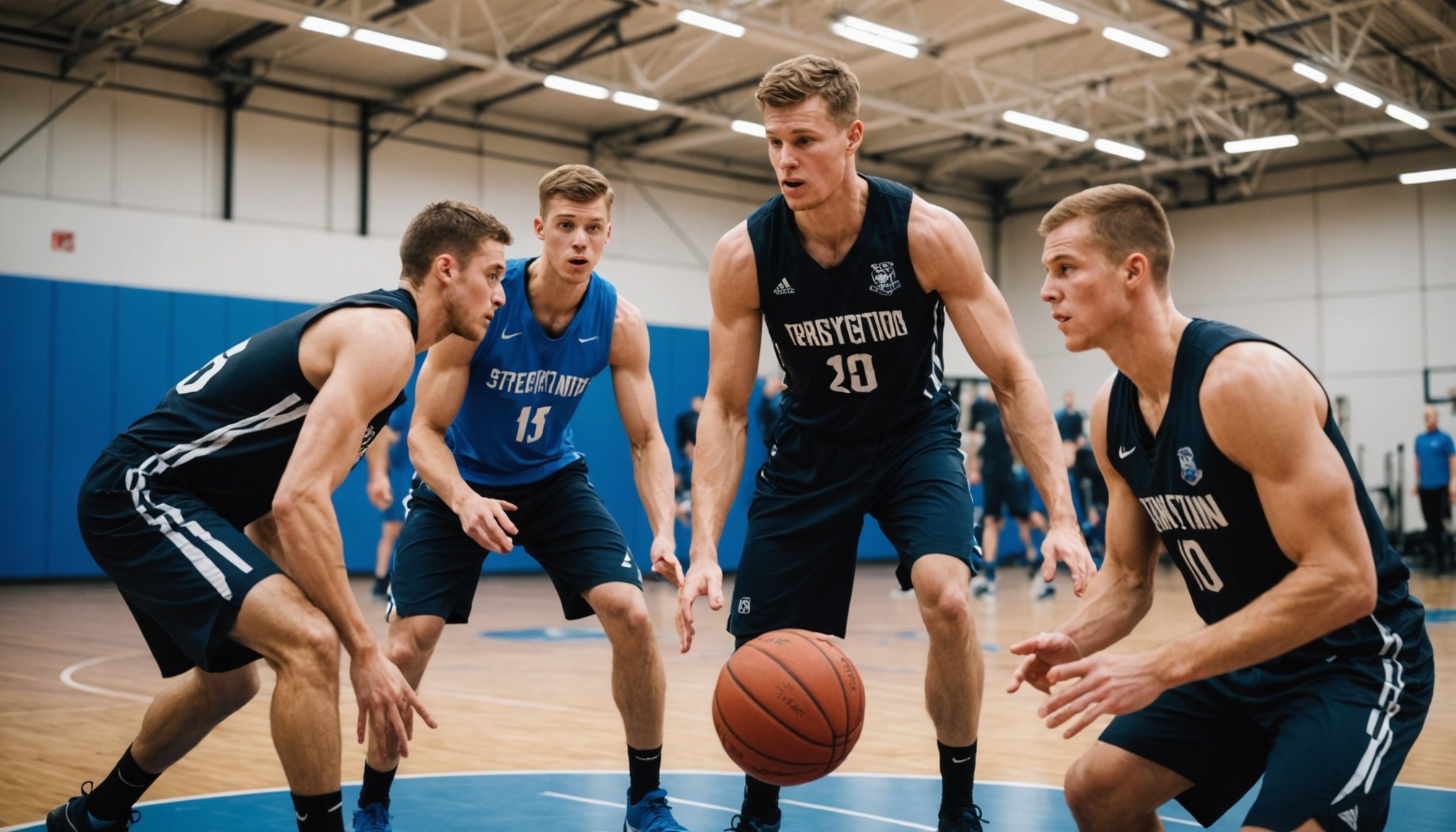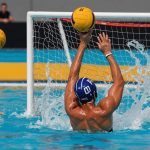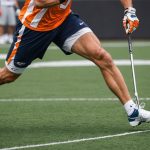Maximizing Performance Potential: The Essential Role of Strength and Conditioning in Training UK Basketball Athletes
When it comes to excelling in basketball, UK athletes understand that mere skill alone is not enough; a robust physical foundation is crucial. Strength and conditioning are the cornerstones of any successful basketball training program, and here’s why.
The Importance of Physical Fitness Components
To excel on the basketball court, players require a well-rounded physical fitness foundation. This encompasses several key components: strength training, cardiovascular fitness, and flexibility.
In parallel : Maximize your game: the ultimate heart rate monitor guide for uk basketball players to boost training efficiency
Strength Training Regimens
Strength training is vital for enhancing a player’s power and agility. A well-structured regimen should include exercises that target both the lower and upper body. For the lower body, squats and deadlifts are essential for jumps and sprints, while bench presses and pull-ups improve upper body strength, aiding in defending and shooting.
- **Squats**: Targets the quadriceps, hamstrings, and glutes, crucial for explosive movements.
- **Deadlifts**: Works multiple muscle groups, including the back, legs, and core, enhancing overall strength.
- **Bench Presses**: Develops chest, shoulder, and tricep strength, vital for shooting and defending.
- **Pull-ups**: Improves back, shoulder, and arm strength, beneficial for rebounding and blocking.
Cardiovascular Conditioning
Cardiovascular fitness is equally important for basketball players. Endurance training tailored to the demands of basketball ensures players maintain high energy levels throughout games. Interval training, which combines high-intensity bursts with recovery periods, mirrors game conditions, improving both aerobic and anaerobic systems. This type of training increases a player’s stamina, ensuring they remain effective throughout a match.
Also read : Speed secrets: proven techniques for uk basketball athletes to boost defensive reaction times
- **Interval Training**: Alternates between high-intensity and low-intensity periods to mimic game conditions.
- **High-Intensity Interval Training (HIIT)**: Involves short bursts of intense exercise followed by brief recovery periods.
- **Endurance Runs**: Long, steady-state runs to build aerobic endurance.
Integrating Skill Development with Physical Conditioning
Balancing skill development with physical conditioning is crucial for athletes. Basketball drills are pivotal in this integration, enhancing both technical abilities and overall fitness.
Incorporating Drills in Conditioning
Incorporating specific basketball drills into conditioning routines is essential. These drills not only target core skills but also improve cardiovascular health and endurance. For example, dribbling while sprinting or shooting after a series of vertical jumps effectively blends skill development with physical conditioning.
- **Dribbling Drills**: Combines dribbling skills with sprinting to improve speed and agility.
- **Shooting Drills**: Involves shooting after explosive movements like vertical jumps to simulate game scenarios.
- **Defensive Drills**: Includes defensive slides and shuttle runs to enhance defensive capabilities.
Game-Specific Skill Training
Training should mimic the intensity and context of actual games. Game-specific skill training focuses on scenarios players face in matches. Implementing drills that reflect real game situations, such as defending under pressure or executing plays that rely on quick decision-making, fosters better overall performance during actual games.
- **Fast Break Drills**: Simulates fast break scenarios to improve transition play.
- **Defensive Switches**: Trains players to handle defensive switches quickly and effectively.
- **Play Execution**: Practices executing plays that require quick decision-making.
Adjusting Training Intensity and Planning for Competitions
Throughout the season, the intensity of training must be modulated to align with the UK basketball context. This modulation ensures that athletes peak at the right time while avoiding burnout.
Modulating Training Intensity
During off-peak periods, focus on building a solid endurance base and refining technique. In contrast, higher intensity training should coincide with competitive phases, maximizing players’ capacity for optimal performance when it counts the most.
- **Off-Season Training**: Focuses on building endurance and refining technique.
- **Pre-Season Training**: Increases intensity to prepare for competitive phases.
- **In-Season Training**: Maintains high intensity while ensuring recovery time.
Planning for Competitions
Aligning conditioning with competition schedules is crucial. By considering these seasonal adjustments, coaches can craft training regimens that account for approaching matches and tournaments. Properly planned training schedules that factor in recovery time, peak performance periods, and strategic rest days will lead to a more consistent and competitive team throughout the season.
- **Recovery Time**: Ensures adequate rest to avoid injury and maintain performance.
- **Peak Performance Periods**: Schedules high-intensity training to coincide with key competitions.
- **Strategic Rest Days**: Includes rest days to allow for recovery and prevent burnout.
Strength and Conditioning for Improved Lateral Movement
Enhancing lateral movement in basketball is not solely about agility drills; it requires a comprehensive strength training and conditioning program.
Key Strength Exercises for Lateral Movement
To support lateral movement, players should focus on exercises like lunges, squats, and deadlifts. These exercises build leg strength, which is vital for explosive side-to-side movements. Incorporating resistance bands can further enhance muscle activation and control.
- **Lunges**: Targets the quadriceps, hamstrings, and glutes, essential for lateral movements.
- **Squats**: Works multiple muscle groups, including the legs and core, enhancing overall strength.
- **Deadlifts**: Develops strength in the back, legs, and core, crucial for explosive movements.
- **Resistance Bands**: Enhances muscle activation and control during lateral movements.
Conditioning Programs Tailored for Basketball
Conditioning programs are designed to improve cardiovascular endurance and muscular stamina, enabling players to maintain high performance throughout a game. High-intensity interval training (HIIT) is particularly effective, as it mimics the short bursts of activity in basketball.
- **HIIT**: Involves short bursts of intense exercise followed by brief recovery periods.
- **Agility Drills**: Includes cone drills, box jumps, and T-drills to improve quickness and responsiveness.
- **Cardiovascular Endurance**: Ensures players can maintain high energy levels throughout games.
Case Studies: Successful Implementation in UK Teams
Examining successful UK basketball teams that have integrated strategic conditioning programs can provide valuable insights.
Examples of UK Basketball Teams Enhancing Lateral Movement
Teams such as the London Lions and the Leicester Riders have demonstrated notable improvements through targeted training programs. The London Lions implemented a specialized agility training regimen focusing on lateral movement drills, resulting in improved defensive capabilities and quicker reaction times on the court. Similarly, the Leicester Riders adopted a comprehensive approach, integrating strength and conditioning exercises alongside agility drills, which significantly boosted their players’ speed and coordination.
- **London Lions**: Implemented agility training focusing on defensive slides and shuttle runs.
- **Leicester Riders**: Combined strength and conditioning exercises with agility drills to enhance speed and coordination.
Analysis of Specific Training Programs and Their Outcomes
The success of these programs lies in their structured approach and consistent implementation. By incorporating exercises like ladder drills and cone drills, both teams reported enhanced agility and overall performance.
| Team | Training Program | Outcomes |
|
|-------------------------------------------|
|
| London Lions | Specialized agility training | Improved defensive capabilities, quicker reaction times |
| Leicester Riders | Comprehensive strength and conditioning | Enhanced speed, coordination, and overall performance |
Expert Insights and Practical Advice
Gleaning expert opinions and understanding real-world applications can pave the way toward more effective basketball conditioning strategies.
Interviews with Coaches
Seasoned basketball coaches emphasize the significance of tailored conditioning programs that cater to individual team needs, focusing on flexibility, strength, and endurance. For instance, coaches highlight that a mix of aerobic and anaerobic exercises ensures players maintain peak performance without compromising on agility.
“A well-structured conditioning program that includes both aerobic and anaerobic exercises is crucial for maintaining peak performance. It ensures our players can sustain high energy levels throughout the game without losing agility.” – Coach, London Lions
Practical Advice for Coaches and Athletes
Here are some practical tips for coaches and athletes looking to enhance their strength and conditioning programs:
- Tailor Programs to Individual Needs: Ensure that the conditioning program is tailored to the specific needs of each player and the team as a whole.
- Incorporate Game-Specific Drills: Use drills that mimic real game scenarios to enhance both physical fitness and technical skills.
- Monitor and Adapt: Regularly monitor the effectiveness of the training program and make necessary adjustments to avoid plateaus and prevent injuries.
- Focus on Recovery: Ensure adequate recovery time to prevent burnout and maintain performance levels.
Strength and conditioning are not just supplementary components of a basketball training program; they are essential for maximizing performance potential. By focusing on strength development, cardiovascular fitness, and flexibility, and by integrating skill development with physical conditioning, UK basketball athletes can significantly enhance their performance on the court.
In the words of a seasoned coach:
“Strength and conditioning are the backbone of any successful basketball team. It’s not just about being strong or fast; it’s about being able to perform at a high level consistently throughout the game.”
By adopting a holistic approach that includes tailored training programs, game-specific drills, and a focus on recovery, UK basketball teams can unlock their full potential and achieve greater success in the sport.











